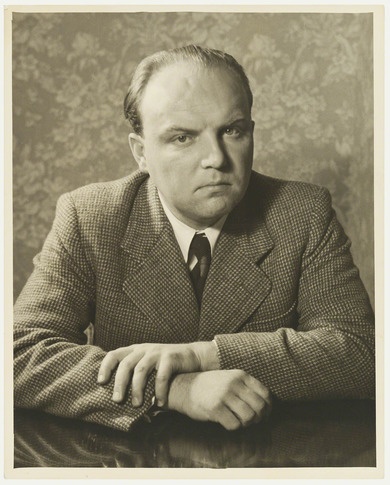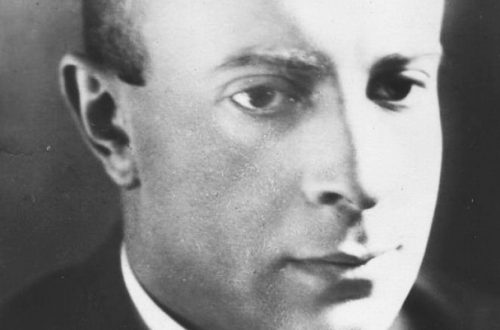
Ernst Krenek (Ernst Krenek) |
Ernst Krenek
On August 23, 2000, the musical community celebrated the centenary of the birth of one of the most original composers, Ernst Krenek, whose work is still ambiguously assessed by critics and listeners. Ernst Krenek, an Austro-American composer, was a full-blooded Austrian despite his Slavic surname. In 1916 he became a student of Franz Schreker, a composer whose works had overtly erotic overtones and were famous for new (musically) elements. At that time, Schreker taught composition at the Vienna Academy of Music. Krenek’s early work (from 1916 to 1920) characterizes him as a composer in search of his own unique style. He pays great attention to counterpoint.
In 1920, Schreker became the director of the Academy of Music in Berlin, and young Krenek continued his studies here. The composer makes friends, including such renowned names as Ferruccio Busoni, Eduard Erdman, Artur Schnabel. This makes it possible for Krenek to receive a certain boost to the already existing, thanks to Schreker, musical ideas. In 1923, Krenek ceased cooperation with Schreker.
The early Berlin period of the composer’s work was called “atonal”, it was marked by striking works, including three expressive symphonies (op. 7, 12, 16), as well as his first opera, written in the genre of the comic opera “Shadow Jump” . This work was created in 1923 and combines elements of modern jazz and atonal music. Perhaps this period can be called the starting point of Krenek’s activity.
In the same 1923, Krenek marries the daughter of Gustav Mahler, Anna. His sensual horizons are expanding, but in music he follows the path of abstract, uncompromising, new ideas. The composer is fond of the music of Bartok and Hindemith, improving his own technique. The maestro’s music is literally saturated with modern motifs, and, first of all, this applies to opera. Experimenting with the opera genre, Krenek saturates it with elements that are not characteristic of classical models.
The period from 1925 to 1927 was marked by Krenek’s move to Kassel and then to Weisbaden, where he learned the basics of musical dramaturgy. Soon the composer met Paul Becker, a conductor who performed at leading opera houses. Becker shows interest in Krenek’s work and inspires him to write another opera. This is how Orpheus and Eurydice appears. The author of the libretto is Oskar Kokoschka, an outstanding artist and poet who wrote a very expressionistic text. The work is replete with a large number of weak points, however, like the previous opera, it is performed in a peculiar, unlike anyone else’s manner, saturated with expression and the composer’s intolerance for any kind of concessions in the name of cheap popularity. Here and healthy egoism, and a dramatic plot, as well as religious and political background. All this makes it possible to speak of Krenek as a bright individualist.
While living in Weisbaden, Krenek composes one of his most striking, and at the same time controversial operas “Johnny plays“. The libretto is also written by the composer. In the production, Krenek uses the most incredible technical achievements (a cordless phone and a real locomotive (!)). The main character of the opera is a Negro jazz musician. The opera was staged in Leipzig on February 11, 1927 and enthusiastically received by the public, the same reaction awaited the opera in other opera houses, where it was subsequently performed, and this is more than 100 different stages, including the Maly Opera and Ballet Theater in Leningrad (1928, penned by S. Samosud). However, critics did not appreciate the opera at its true worth, seeing in it a social and satirical background. The work has been translated into 18 languages. The success of the opera radically changed the life of the maestro. Krenek leaves Weisbaden, divorces Anna Mahler and marries actress Bertha Hermann. Since 1928, the composer has been living in Vienna, touring Europe along the way as an accompanist of his own works. Trying to repeat the success of “Johnny”, he wrote 3 political satirical operas, in addition, a large opera “The Life of Orestes” (1930). All these works impress with the good quality of orchestration. Soon a cycle of songs appears (op. 62), which, according to many critics, was nothing more than an analogue of Schubert’s “Winterreise”.
In Vienna, Krenek again takes the path of rethinking his own musical views.
At that time, the atmosphere of Schoenberg’s followers reigned here, the most famous of which are: Berg and Webern, known for their connections with the Viennese satirist Karl Kraus, who had a large circle of influential acquaintances.
After some thought, Krenek decides to study the principles of Schoenberg’s technique. His introduction to the dodecaphone style was expressed in the creation of variations on a theme for orchestra (op. 69), as well as a well-structured, noteworthy song cycle “Durch die Nacht” (op. 67) to the words of Kraus. Despite his success in this field, Krenek believes that his vocation is opera. He decides to make changes to the opera Orestes and show it to the public. This plan came true, but Krenek was disappointed, the audience greeted the opera very coldly. Krenek continues his careful study of the technique of composition, he subsequently expounds what he has learned in the excellent work “Uber neue musik” (Vienna, 1937). In practice, he uses this technique in “Playing with Music” (opera “Charles V”). This work is staged in Germany from 1930 to 1933. Of particular note is the 1938 production in Prague conducted by Karl Renkl. In this fantastic musical drama, Krenek combines pantomime, film, opera and his own memories. The libretto written by the composer is saturated with Austrian patriotism and Roman Catholic beliefs. Krenek increasingly refers to the role of the nation in his works, which is misinterpreted by many critics of that time. Disagreements with censorship forced the composer to leave Vienna, and in 1937 the composer moved to the United States. Having settled there, Krenek for some time was engaged in writing, composing, and lecturing. In 1939 Krenek taught composition at Vassar College (New York). In 1942 he left this post and became head of the Department of the Fine Arts School of Music in Minnesota, after 1947 he moved to California. In January 1945, he became an official US citizen.
During his stay in the United States from 1938 to 1948, the composer wrote at least 30 works, including chamber operas, ballets, works for the choir, and symphonies (4 and 5). These works are based on a strict dodecaphonic style, while some works are deliberately written without using the dodecaphonic technique. Beginning in 1937, Krenek expounded his own ideas in a series of pamphlets.
Since the beginning of the 50s, Krenek’s early operas have been successfully staged on the stages of theaters in Austria and Germany. The second, so-called period of “free atonality” was expressed in the first string quartet (op. 6), as well as in the monumental first symphony (op. 7), while the culmination of magnificence, perhaps, can be considered the 2nd and 3rd symphonies of the maestro.
The third period of the composer’s neo-romantic ideas was marked by the opera “The Life of Orestes”, the work was written in the technique of tone rows. “Charles V” – the first work of Krenek, conceived in the twelve-tone technique, thus belongs to the works of the fourth period. In 1950, Krenek completed his autobiography, the original of which is kept in the Library of Congress (USA). In 1963, the maestro won the Austrian Grand Prix. All of Krenek’s music is like an encyclopedia listing the musical trends of the time in chronological order.
Dmitry Lipuntsov, 2000





